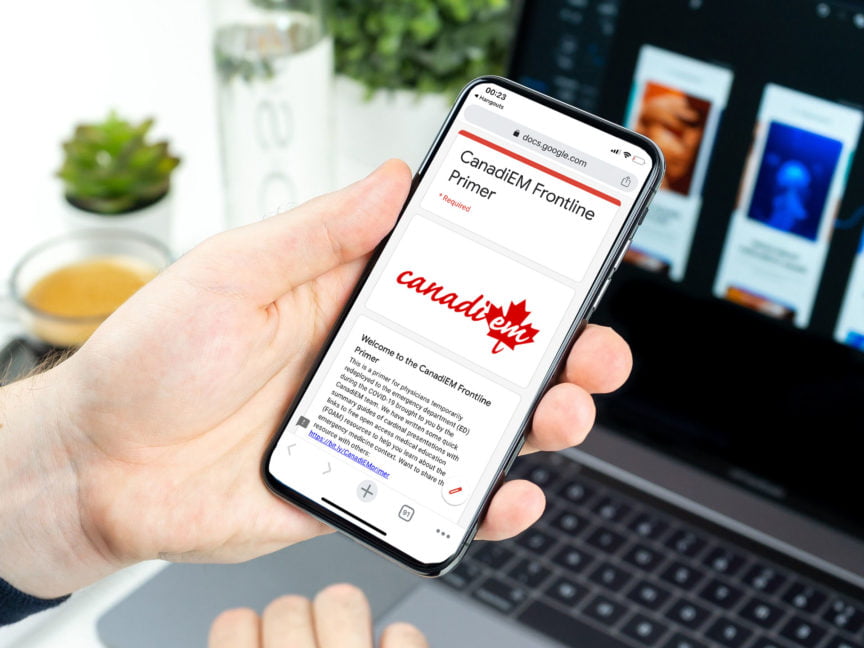Can’t Miss Diagnoses
Multisystem Trauma
- REMEMBER: Trauma violates the Occam’s Razor approach to diagnosis. Unlike multiple-choice questions, multi-system trauma patients require a methodical approach from head to toe. A basic approach will be the classic Advanced Trauma Life Support (ATLS) approach.
- ALSO REMEMBER: Early COVID-19 may present with mild and subtle symptoms (headache, myalgia, etc.) make sure you consider this when receiving a trauma patient. There is enough community spread that trauma patients may be only mildly symptomatic or asymptomatic.
Points to Focus Upon
History
- Trauma history – AMPLE-T – Allergies, Medications, Past Medical History, Last oral intake, Exposures, Tetanus status
- Get handover from paramedics or bystanders at the scene if possible
- For Handovers: SBAR – Situation, Background, Assessment, Recommendation. (Also read our “Handover” section).
Physical exam – BE SYSTEMATIC in Primary Survey
- A – Airway – is it intact? Is the patient breathing?
- B – Breathing – Is the patient breathing spontaneously?
- C – Circulation – see below
- What is their blood pressure? (Cycle this regularly)
- Is the abdomen soft and lax? (If not, surgical consult or eFAST)
- Is their pelvis stable? (If not, apply binder but consider placing a foley first if no blood is present at the urethra)
- D – Disability – see below
- Calculate GCS?
- Pupillary response?
- Is the patient awake/alert/oriented to person, place, time?
- Do they have sensation in all their extremities? Can they move all fingers/toes at baseline level?
- Do they have a c-spine collar on? (Only apply if head/neck injury suspected or known.)
- E – Extremity injuries
- Check all for extremities for signs of deformity, swelling, bleeding.
LOG ROLL THE PATIENT (with c-spine precautions) TO LOOK FOR POSTERIOR THORACIC INJURIES OR SPINAL TENDERNESS.
- Check the axilla for signs of injury (especially with penetrating trauma). If loss of motor/sensory in the lower extremity consider a rectal examination and prostate examination for tone and blood.
- Point-of-Care Ultrasound (to be done only for those with formal training and/or certification for interpretation):
- extended FAST views if the patient is unstable
Investigations
- All investigations should be tailored and led by the clinical acumen of the collective trauma resuscitation team’s wisdom.
Basic Bloodwork for Trauma
- CBC, BUN, Cr, Lytes, Glucose, Liver enzymes (AST, ALT, GGT, ALP, Bilirubin), Lipase, Troponin (Cardiac injury)
- INR/PTT – especially if decreased LOC and unknown medication history
- Group & Screen (especially if patient is bleeding – or has potential of bleeding)
- For women, make sure to test for pregnancy (urine beta-HCG is typical, but in some circumstances it may be advisable and easier to do a serum beta-HCG than to await a urinalysis.)
Basic initial x-rays for a primary trauma survey include:
- Chest X-ray (usually supine)
- C-spine X-ray (usually lateral shoot through)
- Pelvis X-ray
- If you are in a smaller centre, you may well want to call your local trauma hospital for a consultation and possible transfer, before doing any further imaging.
Other adjunctive tests at a trauma hospital
- CT Head
- Spinal imaging – x-rays, or if you can get a CT of that area, and add spinal reformatting
- CT Chest/Abdo/Pelvis*
- Surgical consult (not really a test, but calling a surgeon for help can be very helpful if you are questioning a surgical diagnosis).
- *Highly dependent on the severity of trauma and suspicion for thoracic/abdominal/pelvic trauma or peri-operative planning.
Management
- In Trauma, often effective teams will concurrently assess and manage throughout the resuscitation and should follow the ABC priorities.
- e.g. Airway interventions are completed almost immediately after a problem is noted.
- Interventions beyond this primary survey will often require rapid consultation with a number of team members that may or may not be immediately present (e.g. general surgery, neurosurgery, orthopedics), so be ready to tell this the patient’s multiple times.
- Do not get distracted by obvious but low priority injuries at the cost of high priority but more subtle findings.
- -eg. a wheezing patient should have their airway assessed and monitored before reducing an ankle fracture.
COVID-19 RELEVANT MODIFICATIONS
- DO NOT apply ROUTINE high-flow oxygen at this time due to the risk of COVID-19. Most trauma patients will not need supplemental oxygen, APPLY AS NEEDED for those patients who are hypoxic or if you are preparing for intubation. Bear in mind the personal protective equipment of the rest of your team throughout the resuscitation.
IF AIRWAY INTERVENTIONS ARE NEEDED
- Remember to ensure that proper airway precautions are taken in light of your institution’s COVID-19 plan.
IV MEDICATIONS AND BLOOD PRODUCTS
- Most medications or blood products should be given tailored to the needs of your patient.
- One evidence-based medicine that you should consider is tranexamic acid (1g IV over 10 minutes then 1g IV over next 8 hours for patients over 16 years of age with hemorrhage as SBP <90 mmHg or HR >110).
Recommended reading, videos, and podcasts1
- MedSkl Trauma Video
- ATLS Primary Survey Video (circa 2014)
- MacEmerg Podcast – Trauma Pearls with Dr. Jon Sherbino
- East Guidelines (CAUTION: American Source)
- eFAST module from U of T
For another trauma-related topic, see “Trauma-Isolated Head Injury.“
The following is part of the CanadiEM Frontline Primer. An introduction to the primer can be found here. another trauma-related topic, see “Trauma-Isolated Head Injury.” To return to the Primer content overview click here.
This post was edited by Dr. Jonathan Sherbino MD MEd FRCPC DRCPSC and Dr. Colm McCarthy MD MSc (PGY5, Orthopedics). This post was copyedited and uploaded by Johnny Huang.
References
- 1.Walls R, Hockberger R, Gausche-Hill M. Multiple Trauma. In: Rosen’s Emergency Medicine-Concepts and Clinical Practice e-Book. Elsevier Health Sciences; 2019:.


